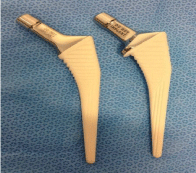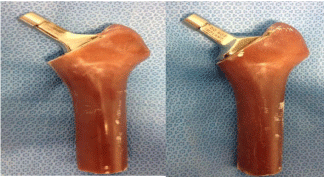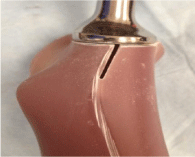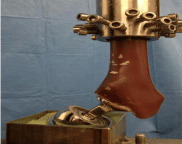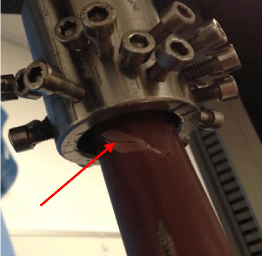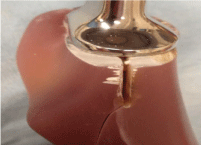Research Article
The Corail® Stem: Does a Collar Improve the Immediate Stability Even in a Present Calcar Split? A Mechanical Study
Tom Adler*, Thomas Schaefer and Piers Yates
Department of Orthopaedic Surgery, Fremantle Hospital and Health Service, Australia
*Corresponding author: Tom Adler, Department of Orthopaedic Surgery, Fremantle Hospital and Health Service, Western Australia
Published: 15 Feb, 2017
Cite this article as: Adler T, Schaefer T, Yates P. The
Corail® Stem: Does a Collar Improve
the Immediate Stability Even in a
Present Calcar Split? A Mechanical
Study. Clin Surg. 2017; 2: 1314.
Abstract
The help of collared Corail® stems in present calcar fractures as well as the influence on stability in a standing position were investigated. 24 femur Sawbones® were dived in 4 groups: Collared stems were compared with collarless as well as calcar split and intact femurs. Mechanical testing was performed on a Zwick/Roell Z010 material testing machine with preloading of 2400 Newton and followed by external rotational load. No loosening was found in intact femurs with collared stems, but loosening with collarless stems at 55.8 Newton. Significantly fewer loads (31.7 N, 24.8 N) were needed in fractured femurs. A collar did not improve the stability significantly. A collar improves the immediate stability, but not in a present calcar fracture of the femur.
Introduction
The Corail® stem is a reliable implant in hip surgery and was first implanted in 1986 [1-7]. A split in the calcar during implantation is relatively common, and may impair the stability of the stem. A collared stem may help in such situations. Advantages and disadvantages about using a collar have been reported in the last decades. Disadvantages include difficulties in achieving proper calcar contact and thus not achieving optimal axial load for immediate stability or offloading of the stem intramedullary leading to a more instability in regard to torsion. Furthermore, a flat collar can decrease the stress transfer in the stem what is needed for proper in growth. Advantages include the avoidance of over-insertion, lower subsidence and aiding to a more stable implant in both young patients with un-cemented stems and older patients with cemented stems [2-12]. For the Corail® stem it is proven that the immediate stability is increased due to the use of a collar for axial load as well as horizontal load imitating torsional load. However, the loads are not tested in combination in order to imitate rotational motions in a standing position [13]. Furthermore, we investigated the influence of a present calcar split on the immediate stability comparing collared and collarless stems.
Material and Methods
Twenty-four femur Sawbones® (item # 3403, medium size, 4th generation) were used for
mechanical testing. The use of Sawbones® has been validated in recent studies [14-17]. The implants
(Corail® Cementless Standard Offset Stem) as well as the instruments were provided by DePuy/
Johnson&Johnson. We compared collared with collarless stems (Figure 1). The 24 Femur Sawbones®
were cut in the diaphysis in order to have identical femurs with the same length (16 cm). The femurs
were then prepared according the usual practice in theatre. Finally, the calcar reamer was used in
order to achieve perfect contact with the collar (Figure 2 and 3). Half of the prepared femurs were
cut in the calcar to simulate a crack (Figure 4). The mechanical testing was performed on a Zwick/
Roell Z010 material testing machine with torsion load as well as axial load sensors. The femurs with
implanted stems were fixed in the machine and a metal-metal acetabular cup/head were used in
order to imitate the acetabular fixation (Figure 5).
All femurs were preloaded with 2400 Newton imitating the average vertical force of a hip in a
single leg stand of an average person with an eighty kilogram body weight [18-20]. After preloading,
all femurs were tested with torsional load in an external rotation direction of the femur. A fracture
of the femur or a sudden loss of load (loosening of the stem) was count as the endpoint of the test.
Results
All tested constructs were able to rotate but with increasing torsion load due to the head-cup fixation proximally. The limit of external rotation in our test setup was 90 degrees, when the greater trochanter came in contact with our metal box containing the acetabular cup. In our test construction all femurs with collared stems without calcar fracture showed neither loosening of the stem nor a fracture of the femur with loosening of the stem. Two of the 6 femurs showed a fracture in the diaphesis close to the fixation in our test construction (Figure 6). Strictly, these fractures could be named as periprosthetic Vancouver Type C fractures. The 4 other femurs reached the construction limit with contacting the greater trochanter with the metal box. The group with collarless stems and intact calcar showed with an average of 62.4 degrees (±8.8°) of external rotation and an average torsion load of 55.8 N (±11.6N) before a fracture with loosening of the stem. The difference is very significant. The calcar split femurs showed a decreased resistance against torsion load with an average load of 31.7 N (±16.1N) with an external rotation of 19° (±7°) even with collared stems. In all femurs the fracture pattern was similar (Figure 7). The same femurs tested with collarless stems fractured with an average torsion load of 24.8N (±7.3N). The difference (p=0.3) is not significant. The difference between collarless stems without calcar split and collared stems with a calcar split is significant (p=0.014).
Figure 1
Figure 2 and 3
Figure 4
Figure 5
Figure 5
Test setup, the acetabular cup is cemented in a metal box, what is
fixed in the testing machine.
Figure 6
Figure 7
Discussion
With our test setup we found a benefit of using collared stems in
order to improve immediate axial stability. Our result is comparable
with current literature [4,5,13]. However, the won some studies could
not show that immediate stability does not lead to a better or earlier
in growth [5,14]. Thus, the calcar provides additional stability for
immediate postoperative time period, which may be useful if any
concerns exist in the bone quality, for instance.
A perfect contact between calcar and collar is mandatory in
order to achieve the desired improved stability. In our pretest we also
tested femurs with collared stems but without perfect contact to the
calcar. The behavior was comparable to collarless stems. But due to the unstandardized testing and very low number of tests these results
cannot be used for evidence. The collar provides an additional surface
as a counterpart especially against axial loads. We hypo the sized
that the additional surface creates a higher resistance to torsional
load. This hypothesis could be confirmed and is comparable with the
current literature [5]. In our pretest we also tested 2 femurs with a
fracture in the greater trochanter. The collared stems implanted in
these femurs showed similar behavior to collared stems implanted in
intact femurs. This result cannot be used for evidence. Nonetheless,
the question became interesting, if the collar provides adequate
stability in femurs with a calcar split since calcar fractures can occur
in implanting of stems like Corail® stems. Although a trend towards
higher stability can be seen with the use of a collared stem in a
calcar split femur, a significant difference could not be found. This
finding is important information for surgeons using these kinds of
stems, because it supports the need for stabilizing an occurred calcar
fracture while implanting the stem. A potential weakness of our study
is the use of Sawbones® instead of cadaveric specimens. As synthetic
bones the Sawbones® provide consistent femur models in comparison
to cadaveric specimens with individual variations. Hence, Sawbones®
may minimize a test bias based on heterogeneous specimens like
altered structures due to osteoporosis. However, the use of Sawbones®
has been validated in recent studies [1,4,8,20].
Conclusion
The collar provides an improved immediate stability if the collar has a perfect contact to the calcar. In cases of an occurred calcar fracture the collared stem does not give adequate stability alone. An additional fixation like a cercalage should be used.
References
- Demey G, Fary C, Lustig S, Neyret P, siSelmi TA. Does a Collar Improve the Immediate Stability of Uncemented Femoral Hip Stems in Total Hip Arthroplasty? A Bilateral Comparative Cadaver Study. J Arthroplasty. 2011; 26: 1549-1555.
- Hallan G, Lie SA, Furnes O, Engesaeter LB, Vollset SE, Havelin LI. Medium- and long-term performance of 11,516 uncemented primary femoral stems from the Norwegian arthroplasty register. J Bone Joint Surg Br. 2007; 89: 1574-1580.
- Havelin LI, Espehaug B, Vollset SE, Engesaeter LB. Early Aseptic Loosening of Uncemented Femoral Components in Primary Total Hip Replacement. A Review Based on the Norwegian Arthroplasty Register. J Bone Joint Surg Br. 1995: 77: 11-17.
- Jameson SS, Baker PN, Mason J, Rymaszewska M, Gregg PJ, Deehan DJ, et al. Independent predictors of failure up to 7.5 years after 35 386 single-brand cementless total hip replacements: a retrospective cohort study using National Joint Registry data. Bone Joint J. 2013; 95: 747-757.
- Kendrick BJ, Wilson HA, Lippett JE, McAndrew AR, Andrade AJ. Corail uncemented hemiarthroplasty with a Cathcart head for intracapsular hip fractures. Bone Joint J. 2013; 95: 1538-1543.
- Vidalain JP. Twenty-year results of the cementless Corail stem. Int Orthop. 2011; 35: 189-194.
- Yates PJ, Serjeant S, Rushforth G, Middleton R. The Relative Cost of Cemented and Un-cemented Total Hip Arthroplasties. J Arthroplasty. 2006; 21: 102-105.
- Carlsson AS, Rydberg J, Onnerfält R. A large collar increases neck resorption in total hip replacement. 204 hips evaluated during 5 years. Acta Orthop Scand. 1995; 66: 339-342.
- Jeon I, Bae JY, Park JH, Yoon TR, Todo M, Mawatari M, et al. The biomechanical effect of the collar of a femoral stem on total hip arthroplasty. Comput Methods Biomech Biomed Engin. 2011; 14: 103-112.
- Zdero R, Shah S, Mosli M, Schemitsch EH. The effect of load application rate on the biomechanics of synthetic femurs. Proc Inst Mech Eng H. 2009; 224: 599-605.
- Mandell JA, Carter DR, Goodman SB, Schurman DJ, Beaupré GS. A conical-collared intramedullary stem can improve stress transfer and limit micromotion. Clin Biomech. 2004; 19: 695-703.
- Manley PA, Vanderby R, Kohles S, Markel MD, Heiner JP. Alterations in Femoral Strain, Micromotion, Cortical Geometry, Cortical Porosity, and Bony Ingrowth in Uncemented Collared and Collarless Prostheses in the Dog. J Arthroplasty. 1995; 10: 63-73.
- Oh I, Harris WH. Proximal strain distribution in the loaded femur. An in vitro comparison of the distributions in the intact femur and after insertion of different hip-replacement femoral components. J Bone Joint Surg Am. 1978; 60: 75-85.
- Speirs AD, Slomczykowski MA, Orr TE, Siebenrock K, Nolte LP. Three-dimensional measurement of cemented femoral stem stability: an in vitro cadaver study. Clin Biomech (Bristol, Avon). 2000; 15: 248-255.
- Whiteside LA, Amador D, Russell K. The effects of the collar on total hip femoral component subsidence. Clin Orthop Relat Res. 1988; 231: 120-126.
- Beingessner D, Moon E, Barei D, Morshed S. Biomechanical analysis of the less invasive stabilization system for mechanically unstable fractures of the distal femur: comparison of titanium versus stainless steel and bicortical versus unicortical fixation. J Trauma. 2011; 71: 620-624.
- Cheng SL, Davey JR, Inman RD, Binnington AG, Smith TJ. The effect of the medial collar in total hip arthroplasty with porous-coated components inserted without cement. An in vivo canine study. J Bone Joint Surg Am. 1995; 77: 118-123.
- Chong AC, Friis EA, Ballard GP, Czuwala PJ, Cooke FW. Fatigue performance of composite analogue femur constructs under high activity loading. Ann Biomed Eng. 2007; 35: 1196-1205.
- Heiner AD. Structural properties of fourth-generation composite femurs and tibias. J Biomech. 2008; 41: 3282-3284.
- Meding JB, Ritter MA, Keating EM, Faris PM. Comparison of Collared and Collarless Femoral Components in Primary Uncemented Total Hip Arthroplasty. J Arthroplasty. 1997; 12: 273-280.

